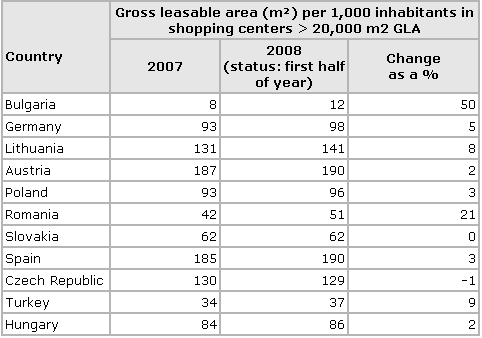12 novembre 2008
"GfK GeoMarketing’s real estate specialists recently researched Europe’s
commercial real estate market. Large-scale projects such as shopping centers
are currently – and will continue to be – major contributors to Europe’s
retail growth.
The research revealed significant differences between Europe’s well
developed markets and the emergent markets in Central and Eastern Europe.
For example, in countries such as Germany, Belgium and Denmark, the sales
area per inhabitant offering is around 1.3 to 1.4 m², or even as high as 1.6
m² in the Netherlands and Austria.
Slovenia, Poland and Hungary lead the pack among the emergent markets in
Central and Eastern Europe. The sales area per inhabitant offering in these
countries is just under 1 m². This impressive performance is mostly due to
large-scale retail formats such as hypermarkets, retail parks and shopping
centers. The leading countries in this group have already surpassed Greece,
the country with the lowest sales area per inhabitant offering in “old
Europe”.
The comparatively lower sales area per inhabitant offering in Europe’s
emergent markets does not mean there is demand for additional sales area in
these locations. This is because the retail boom in these countries is
largely confined to the major cities, some of which already show signs of
overstoring. The rush of retailers, developers and investors has meant that
careful location planning, risk assessment and efforts to ensure long-term
sustainability have been neglected. Some retail locations with less than
ideal sites and problematic branch and tenant mixes have already had to be
completely refurbished. Additional retail locations will meet this same fate
in the near future.
Shopping centers, the most successful phenomenon on the retail real estate
scene, continue to grow in importance; however, their current relevance and
degree of market presence varies significantly by country. They are well
established in western European countries, although their growth percentage
appears relatively modest amidst the overall climate of market saturation.
The shopping center sales area per inhabitant offering differs by country,
with 100 m² per 1,000 inhabitants available in Germany and 200 m² per 1,000
inhabitants in Spain.
Per capita sales area offered by shopping centers (in excess of 20,000 m²
GLA) in selected European countries

Source: GfK GeoMarketing, 2008
The emergent markets in Central and Eastern Europe are also quickly catching
up with regard to shopping center offerings. Following the collapse of
socialism, many of the metropolitan areas in these countries did not adopt
the western model of small-scale, inner-city retail development – the
so-called “High Street” retail environment. Rather, these areas have focused
almost exclusively on large-scale shopping centers.
As a result of this trend, the sales area offerings of shopping centers in
the Baltic states, the Czech Republic and Poland are comparable to the
European average.
“The demand for shopping centers in Central and Eastern Europe is always
initially concentrated in the well-known metropolitan areas. Later, though,
demand expands to secondary and other mid-sized cities,” explains Olaf
Petersen, head of GfK GeoMarketing’s Real Estate Consulting division.
“Although there are numerous opportunities associated with this development,
there is also the risk that careful planning will be neglected amidst the
dynamic growth environment. Merely building a shopping center does not
guarantee its success. Naturally, shopping centers can be positioned more
easily in emergent markets than in highly developed ones. However, the first
warning signs and problems surrounding shopping centers are becoming
apparent in the Baltic states, Turkey and Bulgaria. In short, there are
currently many project locations and concepts that would be best avoided.”
“The solid economic growth in these countries is not a cure-all. While it
may be costly but not necessarily financially fatal to establish a
supermarket that then fails, shopping center endeavors are less forgiving.
Thus, the significant funds required to establish a shopping center should
be preceded by a thorough due diligence study – i.e., a professional
assessment of a given project’s likelihood for success with regard to all
relevant criteria. Well conceived shopping center projects whose intended
locations have been intensively researched are still great investments.” (CS
della Società)